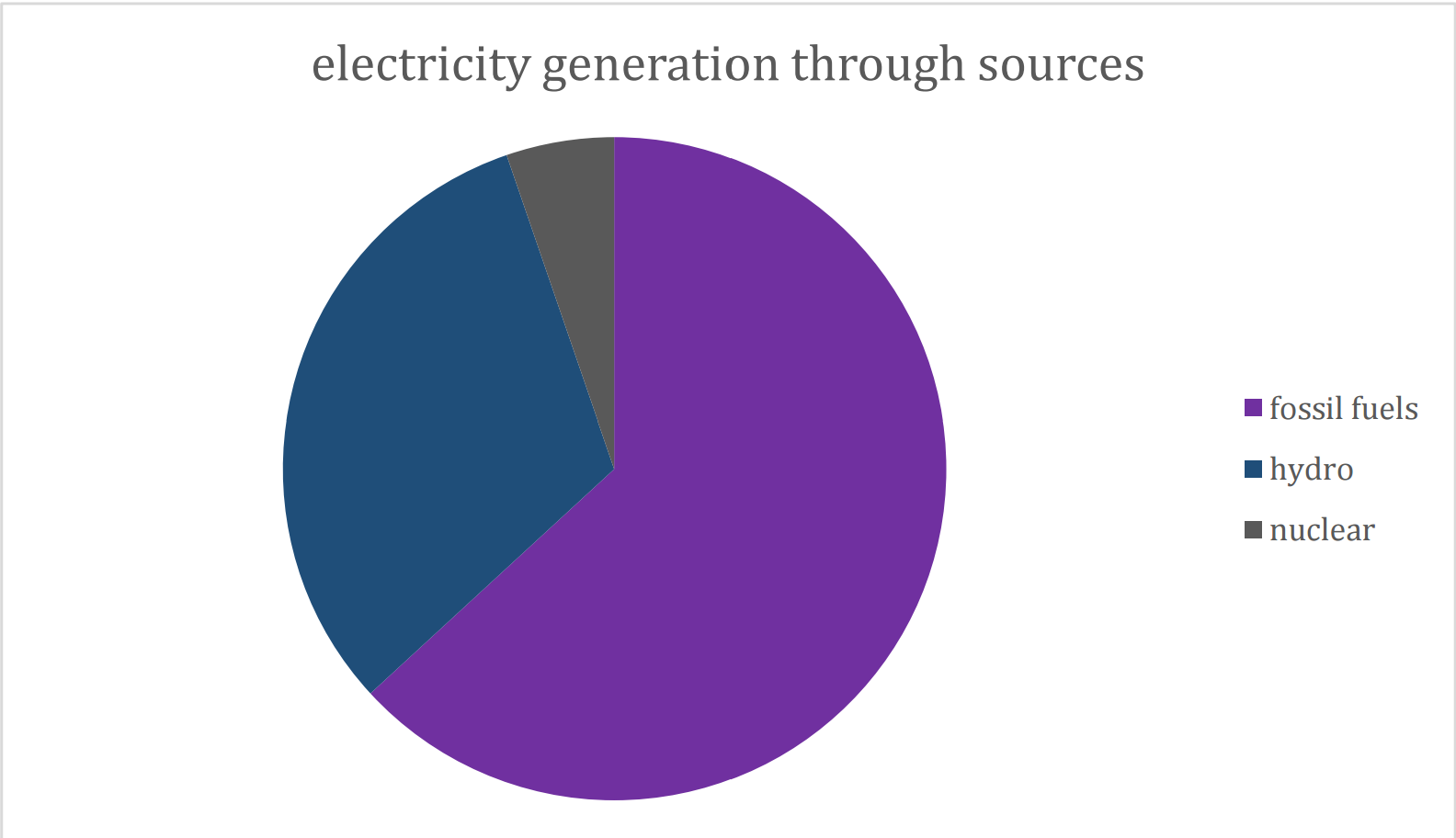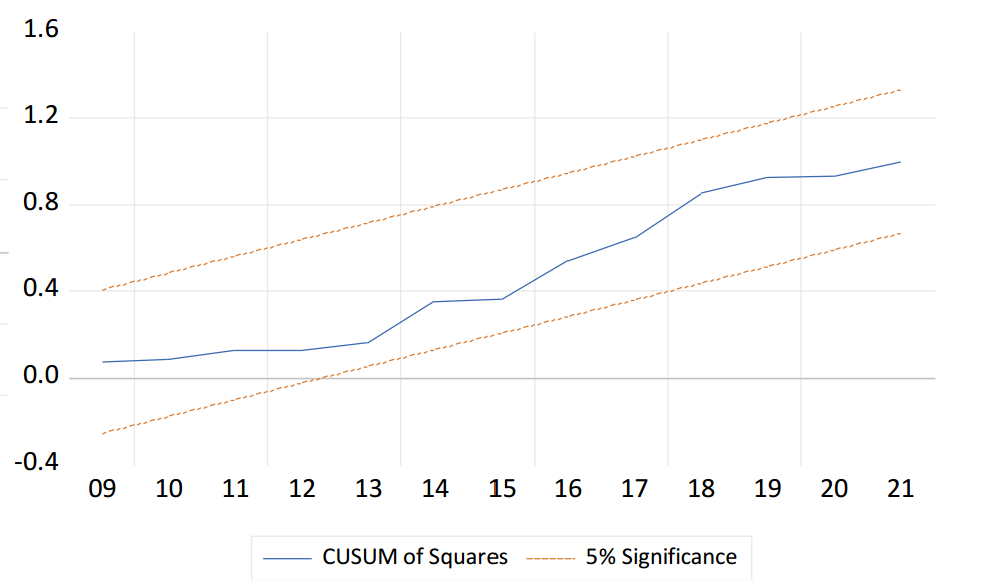Analyzing the Effects of Renewable and Non-renewable Energy Consumption on the Environment and Economic Growth: Panel Data from South Asian Countries
Abstract
The primary goal of this research is to examine how different types of energy are used in South Asian countries and how they affect the environment and economic growth. From 1990 through 2021, this research employed Panel Data from multiple sources covering the South Asian countries of Pakistan, India, Bangladesh, Sri Lanka, Nepal, Bhutan, Maldives, and Afghanistan. The results are determined by using the Fixed Effect Regression (FEM) technique in both models. Several significant findings are supported by the data. First, while using renewable energy flattens carbon dioxide effusion, using non-renewable energy sources increases it. CO2 emissions are affected negatively by gross domestic product but positively by gross domestic product square. These results provide credence to the idea that South Asian countries do experience an Environment Kuznets Curve. Furthermore, foreign direct investment has a beneficial effect on CO2 emissions, lending credence to the Pollution Haven Hypothesis. Model 2 instead finds that both renewable and non-renewable energy consumption contributes to economic expansion. Gross Fixed Capital Formation and foreign direct investment also contribute to economic growth in this area. Finally, Inflation retards economic expansion.
Cite This Paper
Husnain, M. A., Guo, P., Pan, G., Bhatti, M. K., & Islam, R. (2024). Analyzing the Effects of Renewable and Non-renewable Energy Consumption on the Environment and Economic Growth: Panel Data from South Asian Countries. Energy Technologies and Environment, 2(1), 6. doi:10.58567/ete02010001
Husnain, M. A.; Guo, P.; Pan, G.; Bhatti, M. K.; Islam, R. Analyzing the Effects of Renewable and Non-renewable Energy Consumption on the Environment and Economic Growth: Panel Data from South Asian Countries. Energy Technologies and Environment, 2024, 2, 6. doi:10.58567/ete02010001
Husnain M A, Guo P, Pan G et al.. Analyzing the Effects of Renewable and Non-renewable Energy Consumption on the Environment and Economic Growth: Panel Data from South Asian Countries. Energy Technologies and Environment; 2024, 2(1):6. doi:10.58567/ete02010001
Husnain, Muhammad A.; Guo, Ping; Pan, Guoqin; Bhatti, Muhammad K.; Islam, Rabia 2024. "Analyzing the Effects of Renewable and Non-renewable Energy Consumption on the Environment and Economic Growth: Panel Data from South Asian Countries" Energy Technologies and Environment 2, no.1:6. doi:10.58567/ete02010001
Share and Cite
Article Metrics
References
- Ahmad, A., Zhao, Y., Shahbaz, M., Bano, S., Zhang, Z., Wang, S., & Liu, Y. (2016). Carbon emissions, energy consumption, and economic growth: An aggregate and disaggregate analysis of the Indian economy. Energy Policy 96, 131-143. https://doi.org/10.1016/j.enpol.2016.05.032
- Adams, S., Klobodu, E. K. M., & Apio, A. (2018). Renewable and non-renewable energy, regime type, and economic growth. Renewable Energy 125, 755-767. https://doi.org/10.1016/j.renene.2018.02.135
- Akinlo, A. E. (2008). Energy consumption and economic growth: Evidence from 11 Sub-Sahara African countries. Energy economics 30(5), 2391-2400. https://doi.org/10.1016/j.eneco.2008.01.008
- Alam, M. J., Begum, I. A., Buysse, J., Rahman, S., & Van Huylenbroeck, G. (2011). Dynamic modeling of a causal relationship between energy consumption, CO2 emissions, and economic growth in India. Renewable and Sustainable Energy Reviews 15(6), 3243-3251. https://doi.org/10.1016/j.rser.2011.04.029
- Alkhathlan, K., & Javid, M. (2013). Energy consumption, carbon emissions and economic growth in Saudi Arabia: An aggregate and disaggregate analysis. Energy Policy 62, 1525-1532. https://doi.org/10.1016/j.enpol.2013.07.068
- Apergis, N., & Payne, J. E. (2009). CO2 emissions, energy usage, and output in Central America. Energy Policy 37(8), 3282-3286. https://doi.org/10.1016/j.enpol.2009.03.048
- Apergis, N., Payne, J. E., Menyah, K., & Wolde-Rufael, Y. (2010). On the causal dynamics between emissions, nuclear energy, renewable energy, and economic growth. Ecological Economics 69(11), 2255-2260. https://doi.org/10.1016/j.ecolecon.2010.06.014
- Asafu-Adjaye, J. (2000). The relationship between energy consumption, energy prices, and economic growth: time series evidence from Asian developing countries. Energy economics 22(6), 615-625. https://doi.org/10.1016/S0140-9883(00)00050-5
- Balsalobre-Lorente, D., Gokmenoglu, K. K., Taspinar, N., & Cantos-Cantos, J. M. (2019). An approach to the pollution haven and pollution halo hypotheses in MINT countries. Environmental Science and Pollution Research 26, 23010-23026. https://doi.org/10.1007/s11356-019-05446-x
- Belaïd, F., & Zrelli, M. H. (2019). Renewable and non-renewable electricity consumption, environmental degradation and economic development: evidence from Mediterranean countries. Energy Policy 133, 110929. https://doi.org/10.1016/j.enpol.2019.110929
- Bölük, G., & Mert, M. (2014). Fossil & renewable energy consumption, GHGs (greenhouse gases) and economic growth: Evidence from a panel of EU (European Union) countries. Energy 74, 439-446. https://doi.org/10.1016/j.energy.2014.07.008
- COP. (2016). Paris Climate Change Conference - November 2015. Retrieved from https://unfccc.int/process-and-meetings/conferences/pastconferences/paris-climate-change-conference-november-2015/cop-21
- Eggoh, J. C., Bangake, C., & Rault, C. (2011). Energy consumption and economic growth revisited in African countries. Energy Policy 39(11), 7408-7421. https://doi.org/10.1016/j.enpol.2011.09.007
- Fan, F., & Lei, Y. (2017). Responsive relationship between energy-related carbon dioxide emissions from the transportation sector and economic growth in Beijing-Based on decoupling theory. International Journal of Sustainable Transportation 11(10), 764-775. https://doi.org/10.1080/15568318.2017.1317887
- Ivanovski, K., Hailemariam, A., & Smyth, R. (2021). The effect of renewable and non-renewable energy consumption on economic growth: Non-parametric evidence. Journal of Cleaner Production 286, 124956. https://doi.org/10.1016/j.jclepro.2020.124956
- Isik, C., Ongan, S., Ozdemir, D., Ahmad, M., Irfan, M., Alvarado, R., & Ongan, A. (2021). The increases and decreases of the environment Kuznets curve (EKC) for 8 OECD countries. Environmental Science and Pollution Research 28, 28535-28543. https://doi.org/10.1007/s11356-021-12637-y
- IPCC. (2014). Climate change 2014, synthesis report, summary for policymakers. Retrieved from http://www.ipcc.ch/pdf/assessmentreport/ar5/syr/AR5_SYR_FINAL_SPM.pdf
- Ito, K. (2017). CO2 emissions, renewable and non-renewable energy consumption, and economic growth: Evidence from panel data for developing countries. International Economics 151, 1-6. https://doi.org/10.1016/j.inteco.2017.02.001
- Joyeux, R., & Ripple, R. D. (2011). Energy consumption and real income: A panel cointegration multi-country study. The Energy Journal 32(2). https://doi.org/10.5547/ISSN0195-6574-EJ-Vol32-No2-5
- Kisswani, K. M., & Zaitouni, M. (2021). Does FDI affect environmental degradation? Examining pollution haven and pollution halo hypotheses using ARDL modeling. Journal of the Asia Pacific Economy, 1-27
- Lee, J. (2019). Long-run dynamics of renewable energy consumption on carbon emissions and economic growth in the European Union. International Journal of Sustainable Development & World Ecology 26(1), 69-78. https://doi.org/10.1080/13504509.2018.1492998
- Mert, M., & Caglar, A. E. (2020). Testing pollution haven and pollution halo hypotheses for Turkey: a new perspective. Environmental Science and Pollution Research 27, 32933-32943. https://doi.org/10.1007/s11356-020-09469-7
- Mahadevan, R., & Asafu-Adjaye, J. (2007). Energy consumption, economic growth and prices: A reassessment using panel VECM for developed and developing countries. Energy Policy 35(4), 2481-2490. https://doi.org/10.1016/j.enpol.2006.08.019
- Mohsin, M., Kamran, H. W., Nawaz, M. A., Hussain, M. S., & Dahri, A. S. (2021). Assessing the impact of transition from nonrenewable to renewable energy consumption on economic growth-environmental nexus from developing Asian economies. Journal of environmental management 284, 111999. https://doi.org/10.1016/j.jenvman.2021.111999
- Opeyemi, A. F. (2020). Impact of foreign direct investment and inflation on economic growth of five randomly selected Countries in Africa. Journal of Economics and International Finance 12(2), 65-73. https://doi.org/10.5897/JEIF2020.1031
- Olivier, J. G., Peters, J. A., & Janssens-Maenhout, G. (2012). Trends in global CO2 emissions. 2012 report
- Ouedraogo, N. S. (2013). Energy consumption and economic growth: Evidence from the economic community of West African States (ECOWAS). Energy economics 36, 637-647. https://doi.org/10.1016/j.eneco.2012.11.011
- Pirlogea, C., & Cicea, C. (2012). Econometric perspective of the energy consumption and economic growth relation in European Union. Renewable and Sustainable Energy Reviews 16(8), 5718-5726. https://doi.org/10.1016/j.rser.2012.06.01
- Rahman, M. M., & Velayutham, E. (2020). Renewable and non-renewable energy consumption-economic growth nexus: new evidence from South Asia. Renewable Energy 147, 399-408. https://doi.org/10.1016/j.renene.2019.09.007
- Sahoo, M., & Sahoo, J. (2020). Effects of renewable and non‐renewable energy consumption on CO2 emissions in India: Empirical evidence from disaggregated data analysis. Journal of Public Affairs. https://doi.org/10.1002/pa.2307
- Sargolzaiea, A., & Ghasemib, S. (2022). Investigating the effect of renewable and non-renewable energy consumption on CO2 emissions in Asian countries. http://dx.doi.org/10.6084/m9.figshare.19368575.v1
- Shafiei, S., & Salim, R. A. (2014). Non-renewable and renewable energy consumption and CO2 emissions in OECD countries: a comparative analysis. Energy policy 66, 547-556. https://doi.org/10.1016/j.enpol.2013.10.064
- Shahbaz, M., Raghutla, C., Chittedi, K. R., Jiao, Z., & Vo, X. V. (2020). The effect of renewable energy consumption on economic growth: Evidence from the renewable energy country attractive index. Energy 207, 118162. https://doi.org/10.1016/j.energy.2020.118162
- Shahbaz, M., Zakaria, M., Shahzad, S. J. H., & Mahalik, M. K. (2018). The energy consumption and economic growth nexus in top ten energy-consuming countries: Fresh evidence from using the quantile-on-quantile approach. Energy Economics 71, 282-301. https://doi.org/10.1016/j.eneco.2018.02.023
- Shayanmehr, S., Rastegari Henneberry, S., Sabouhi Sabouni, M., & Shahnoushi Foroushani, N. (2020a). Climate Change and Sustainability of Crop Yield in Dry Regions Food Insecurity. Sustainability 12(23), 9890. https://doi.org/10.3390/su12239890
- Solarin, S. A., Al-Mulali, U., Gan, G. G. G., & Shahbaz, M. (2013). The impact of biomass energy consumption on pollution: evidence from 80 developed and developing countries. Environmental Science and Pollution Research 25, 22641-22657. https://doi.org/10.1007/s11356-018-2392-5



